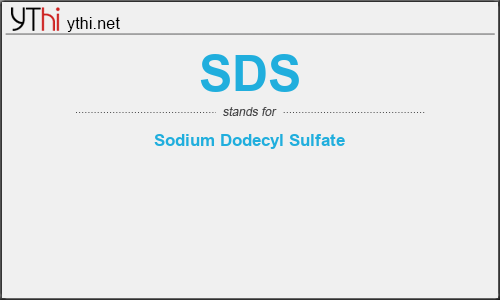What does SDS mean? What is the full form of SDS?
The full form of SDS is Sodium Dodecyl Sulfate.
Sodium dodecyl sulfate (SDS), also known as lauryl sulfate, is an ionic detergent that is useful for the rapid disruption of biological membranes. It is a key component of many reagents used to purify nucleic acids because of its abilities to quickly disrupt the tissue architecture and to inhibit both RNase and deoxyribonuclease (DNase) activity. SDS is usually prepared as either a 10% or a 20% (w/v) stock solution and is used most often at a working concentration of 0.1% to 0.5%. The performance of this detergent can be affected significantly by its purity. SDS is easily precipitable in the presence of potassium salts and generally is not added to guanidinium buffers, as it has very low solubility in high-salt, chaotropic solutions.
SDS electrophoresis was the next logical step after disk electrophoresis. While the latter discriminates macromolecules on the basis of both size and surface charge, SDS electrophoresis fractionates polypeptide chains essentially on the basis of their size. It is therefore a simple, yet powerful and reliable method for molecular mass (Mr) determination. In 1967, it was first reported that electrophoretic migration in SDS is proportional to the effective molecular radius and thus to the Mr of the polypeptide chain. This result means that SDS must bind to proteins and cancel out differences in molecular charge, so that all components then migrate solely according to size. Surprisingly large amounts of SDS appear to be bound (an average of 1.4 g SDS per gram of protein), which means that the number of SDS molecules bound is of the order of half the number of amino acid residues in a polypeptide chain. This amount of highly charged surfactant molecules is sufficient to overwhelm effectively the intrinsic charges of the polymer coil, so that their net charge per unit mass becomes approximately constant. If migration in SDS (and disulfide reducing agents, such as 2-mercaptoethanol, in the denaturing step, for a proper unfolding of the proteins) is proportional only to molecular mass, then, in addition to canceling out of charge differences, SDS also equalizes molecular shape differences as well (e.g., globular versus rod-shaped molecules). This seems to be the case for protein–SDS mixed micelles: these complexes can be assumed to behave as ellipsoids of constant minor axis (∼1.8 nm) and with the major axis proportional to the length in amino acids (i.e., to molecular mass) of the protein. The rod length for the 1.4 g SDS/g protein complex is of the order of 0.074 nm per amino acid residue.
SDS
means
Sodium Dodecyl Sulfate![]()
Translate Sodium Dodecyl Sulfate to other language.


Leave a Reply
You must be logged in to post a comment.